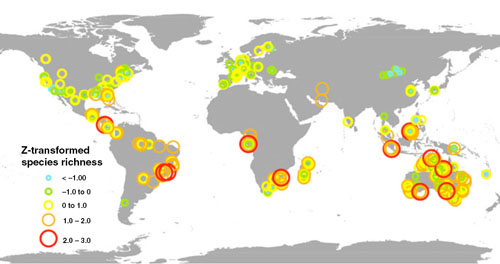
A bold paper by Rob Dunn et al in Ecology Letters is making news this month.  Dunn and an impressive list of coauthors pool observations of ant species richness from more than 1000 sites worldwide, finding that southern hemisphere habitats consistently support more species than their equivalents in the northern hemisphere. The pattern appears to be predicted primarily, but not entirely, by climate.
These results strike me as intuitively correct, and I suspect anyone who has collected ants in both hemispheres will agree. Brazil's fauna is spectacularly rich. That of Oklahoma, less so.
But intuition is a self-reinforcing trap, so we'll want to evaluate the study based on more objective criteria. And there are a couple things here that make me uncomfortable. Not with this study per se, but with macroecological studies in general that rely on aggregated data from different sources.
The first problem is that the data from different sites were not collected using the same methods. Most were tallied from studies designed for other purposes. The authors were careful to exclude studies that were vastly different in methodology, but as each site was surveyed by different teams using somewhat different equipment, it is hard to ascertain the extent to which data across sites really are comparable. This might not matter, especially if biases are distributed at random among the studies, but it's still something to keep in mind.
The second problem is taxonomic and not mentioned in the paper.  Indeed, taxonomic assumptions are considered all too rarely in ecology anyway. But I digress. I'm referring to a lack of a universal standard among sites in the fundamental unit of measurement, the species. Where one taxonomist might discern a single variable species, another may see a dozen, and the resulting taxonomic bias can drive a lot of spurious patterns.
For example, a number of the Australian samples were sorted by myrmecologist Alan Anderson, who recognizes quite a lot of slight distinctions as species (a "splitter", as we say), while North American samples were sorted by myrmecologists who tend towards the opposite end of the spectrum ("lumpers"; of which we have a long tradition on this continent). Such perception bias towards Australian and away from northern richness could severely confound the analyses.  In this case, the authors reached the same result both with and without Australia, so I'm probably overblowing this criticism here. All the same, I'd be interested to see if adopting a universal genetic standard for measuring diversity would alter the results.
One additional issue has to do with an explanation invoked to explain the disparity between hemispheres. Dunn et al postulate an elevated northern extinction rate, arguing that northern ants go extinct more often than southern ants, leading to fewer northern species overall. That may or may not be true, but the data set here is simply inadequate for the question. The extinction hypothesis is historical in nature and really requires a phylogenetic framework. It may well be, for example, that overall speciation and extinction rates are the same in both hemispheres, but that the Southern fauna is simply older, allowing for the accrual of more species. A simple tally of species richnesses won't allow us to test this conjecture, but a phylogeny can.
Regardless of my nitpicks here, Dunn et al martial an impressive amount of data to answer an intrinsically hard question: why are there more species in some places than others?  This ambitious global perspective will become increasingly important as scientists grapple with the problem of climate change, so expect to see more of this kind of research in the not-to-distant future.
source: Dunn et al. Climatic drivers of hemispheric asymmetry in global patterns of ant species richness. Ecology Letters, 2009; 12 (4): 324 DOI: 10.1111/j.1461-0248.2009.01291.x

I wonder if there's also a sampling effect, say less ant taxonomy going on in that big blank space in Eurasia. No ants in Thailand/ Cambodia/ Vietnam?
I share Ainsley's concern about sampling bias. We've only just begun sampling Philippine ants intensively. And precious little of our findings have been published. We are seeing that each island in the archipelago seems to have its own unique assemblage of species.
For one thing, Brazil is also much, much larger than Oklahoma. I therefore scoff at your feeble metaphor. Or maybe you were thinking "Belize", which sounds vaguely similar to Brazil. ;-)
You do, however, have a point about the importance of taxonomic resolution. I can't wait until we have an intelligent way to measure, and think about, genomes as we quantify biodiversity gradients.